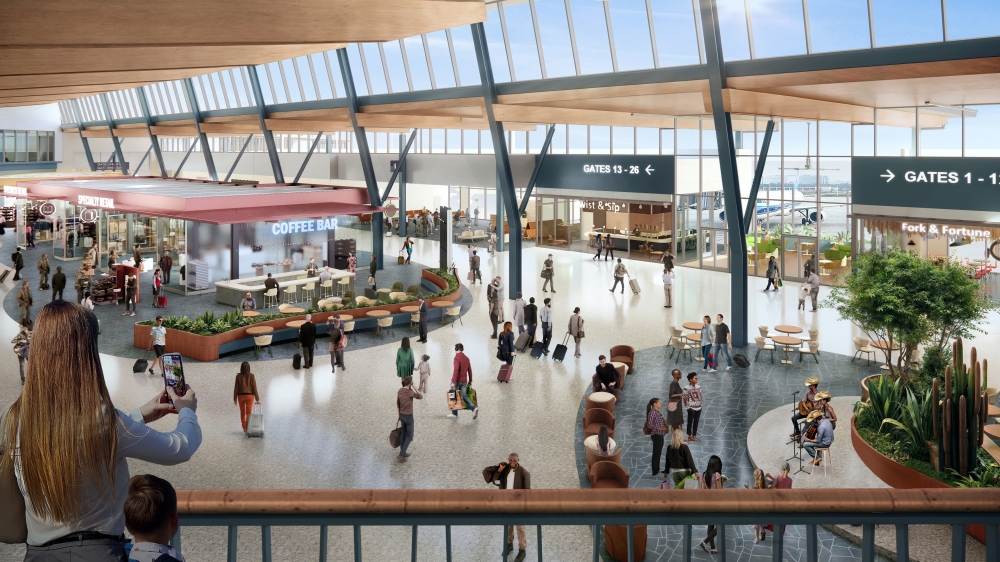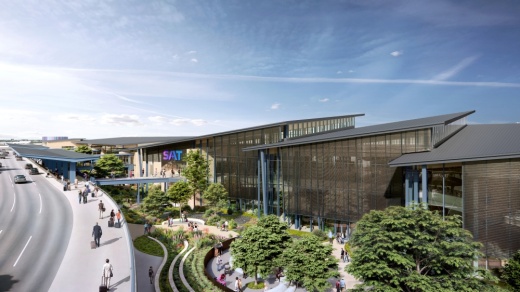On Dec. 10, city officials broke ground on the new terminal which has been in development since City Council approved the plan in November 2021.
San Antonio International Airport’s new 850,000-square-foot terminal is designed to accommodate the region’s growth over the next 20 years.
District 10 City Council Member Marc Whyte said the terminal project stands out from other San Antonio development projects—like the sports and entertainment district and the downtown baseball park—because it will spur economic development in a variety of ways, such as growing the city’s tourism industry, creating a bigger draw for regional use and creating better access to the city for national and international businesses.
Tim O’Krongley, San Antonio Aviation Department’s deputy director of development, said the airport’s annual revenue grew from $5 billion to $7.4 billion in 2024.
“[The terminal project is] going to be something that's going to allow us to create more jobs here in our city, better paying jobs and really elevate life for all of our citizens,” Whyte said.
The overview
The airport’s master plan, which helps guide future development, forecasts an average of 13 million passengers a year by 2030 and over 16 million passengers by 2040.
“[SA Airport] set records last year, and we're projected to continue to keep setting record numbers,” O’Krongley said.
To accommodate this growth, the new terminal will add an additional 17 gates by mid-2028, with larger gate hold rooms for passengers, 410,000-square-feet of new concession space, roadway improvements, an extended runway and a modern federal inspection station for expanded international travel.
“[The new terminal will] enhance the customer experience, the level of service, the offerings that we can offer to the airlines and ultimately growth for the airport and our community,” O’Krongley said.Funding the project
Projected to be 30% larger than both current terminals combined, the new terminal’s construction is funded through a mix of revenue bonds, federal grants and airport revenue.
“The airport [terminal development project] is unique because that’s being funded through airport revenue and through federal money, so [the cost is] not going to be on the back of San Antonio taxpayers,” Whyte said.
O’Krongley said most projects initiated by the airport are funded through federal grants.
“Capitol programs are mostly funded through FAA grant programs that the aviation department pursues,” O’Krongley said.
Airport officials said the majority of the project will be funded through General Airport Revenue Bonds, which are recovered through rents, rates and charges. Additional funds will come from passenger facility charges and federal grants from the Federal Bipartisan Infrastructure Law and the Federal Aviation Administration.The approach
John Trupiano—principal at architecture and design firm Corgan–said the new terminal is designed to allow San Antonio’s medium airport hub to grow with its population.
“San Antonio is a mid-sized hub, but it’s a mid-sized hub in one of the nation’s largest cities, and it’s important that we develop a facility that allows it to grow and really serve the demographics of the city,” Trupiano said.
Aesthetically, the new terminal will reflect San Antonio’s unique culture and environment. This includes developing a riparian paseo that showcases local flora as an indoor-outdoor transition space, a water feature reminiscent of the River Walk, a stage for live music, a mercado designed to invoke the historic market square and an expanded USO for military personnel.
On top of the expanded capacity and creating a sense of place, the terminal design prioritizes sustainability.
The sustainable innovations in the design include low energy glazing glass panes, solar shades, natural light and using wastewater to water plants in the terminal.
“Water is very critical in the region [and] we want to be good stewards, so it gives us an opportunity with all the water that we have here that would otherwise just be sent somewhere else, [and] we can utilize [the wastewater] to water plants in the Paseo,” O’Krongley said.

Scheduled to be completed late 2025, the airport’s new ground loading facility will feature additional room for passengers on two levels and add three extra gates.
Once completed, Terminal C will provide a 63% increase in the number of airport gates, and will create an estimated 16,000 jobs over its lifespan. Additionally, the ground transportation center—estimated to be completed in 2028—will create better access to ground transportation options, such as rideshares and taxis.
Whyte believes the increased ease of travel provided by the terminal project will attract more businesses to San Antonio.
“One of the things that [businesses] are always looking for when they're looking at business partners or where to set up a headquarters or a second location, is the ease of being able to get to and from that particular location. The new terminal [will] make it easier to get in and out of San Antonio. [Additionally] the airport experience will be that much better, and that can create business for our city,” Whyte said.
Construction timeline:
- The new ground load facility is estimated to be completed late 2025
- The new terminal broke ground in December, 2024, and construction is estimated to be completed mid-2028
- Upgrades to field and roadway TBD





